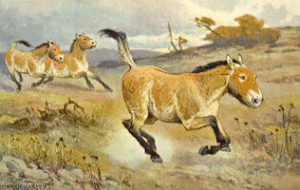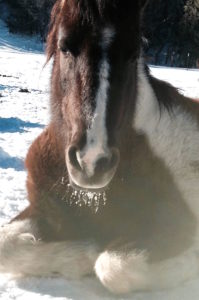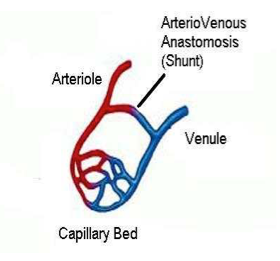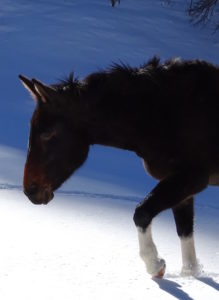 Editor’s Note: Horses are dramatically different mammals than humans, and, yet, we continue to treat them as if they had the same physiological conditions and needs. In this post, Best Horse Practices Summit board member and Southern Illinois University professor emeritus Dr. Sheryl King helps us understand why horses don’t suffer from frostbite.
Editor’s Note: Horses are dramatically different mammals than humans, and, yet, we continue to treat them as if they had the same physiological conditions and needs. In this post, Best Horse Practices Summit board member and Southern Illinois University professor emeritus Dr. Sheryl King helps us understand why horses don’t suffer from frostbite.
Dr. Sheryl King writes:
The horse evolved beside glaciers during the Pleistocene era (that began about 2.6 million years ago and lasted until about 11,700 years ago) and still survives in Mongolia where even the cold we are experiencing in the United States is comparably, laughably warm.

Pre-Przewalski horses
It is almost inconceivable that a horse’s extremities would suffer frostbite.
Why?
They have a built-in, countercurrent blood circulation exchanger in the extremities that keeps the hot blood from getting to the extremities where it will ultimately cool their core temperature. They also have a fascinating system of capillary shunts that keep the skin in those areas just above freezing temps.

No frostbite here
Ever wonder why the fins on whales, walruses, and seals don’t freeze in the arctic? They have such a large surface area that are exposed to sub-zero temperatures all the time, and very little fat covering in that area. Consider, too, the hooves of moose, elk, deer, or the ears of hares? These mammals have the same blood circulation exchange system.
In the extremities, there is a tangle of blood vessels where the arteries coming from the body are wrapped closely around the veins returning from the extremities to the core. This anatomy doesn’t exist in the rest of the body.
The capillaries that nourish the far-away tissues are between the arteries and veins. They are so tiny and have such a large surface area that pumping warm, core-body temperature blood into them would cool off the entire body.
So Mother Nature devised two things to help.
First, the tangled veins and arteries are touching which allows hot blood coming from the core to share heat with the cool blood in the veins coming back from the ears or hooves. By the time the arterial blood reaches the capillaries, it is significantly cooled and will not contribute to making the entire horse cold.

Arteriovenous anastomoses
Second, there are tiny shunts – think of them as short-circuits if you will – between the smallest arteries and veins in the extremities. They are called arteriovenous anastomoses.
These shunts have a valve that is closed most of the time, allowing the arteries to pump blood efficiently into the capillaries and from there back into the veins and back to the heart.
However, when it is extremely cold, these shunts open and divert the arteriole blood directly into the venuole and then back to the body, bypassing the capillaries. This shunting also cools down the extremities and conserves body heat. The shunts are designed to open and close so that enough blood will make it to the capillaries to keep the flesh alive and keep the temperature there just above the freezing mark.
Pretty cool system, huh?

No frost bite here, either
Humans have this system, too. Watch your hands in the cold; they will go through the ‘flush’ reaction and suddenly turn red. Then, they will revert to normal coloring or even pale. It happens in our ears even more noticeably.
Unfortunately, we humans don’t have a well-engineered hair coat that also insulates, so our countercurrent exchange system doesn’t work all that well to keep our extremities from freezing. We do get frostbite easily.
So when someone says something like “if the horse’s ears are cold, the horse is cold,” you now that it just ain’t so. I hope you will remember this explanation and be able to tell them why the horse’s ears are designed to be cold – just not cold enough to freeze.
Read related post: Donkeys: We Don’t Need No Stinkin’ Blankets!
This is super information! Great explanation….now I need to keep re-reading to understand enough to explain to others. Thanks so much for sharing your knowledge.
Excellent, well reasoned article. However with any situation there are exceptions that need to be noted.
While the argument regarding blankets and circulation is spot on, in my opinion, we have observed high desert range horses following an extremely prolonged deep and windy cold spell with ear tips missing from frostbite. We call them “kangaroo ears” due to their remodeled shapes. Not to say that a healthy horse in such conditions won’t adapt quite successfully to extreme weather. My point is that there are limitations with respect to extreme conditions.
However my big concern involves hypothermia. Having dealt with a few of those cases out on the range, generally due to horses falling through the ice, bogged in chilly mud, or domestic horses getting soaked by sleet followed by strong winds, horses can reach a point where competent veterinary assistance (such as core rewarming) may be essential for survival. A rectal temperature of around 92f warrants careful proper handling before formal veterinary care and appropriate professional treatment. Otherwise fatal implications may manifest within a few days of the event.
Please note that I’m not quarreling at all regarding the issue of overuse of blankets (which can compromise a horse’s natural temperature regulation) and similar advice posted here. In short, horses generally are much happier in temperatures we find unpleasantly cold. Just don’t be oblivious to those rare but extreme and dangerous exceptions that, given the right circumstances, can occur.
Nice! Informative and interesting!
TY
Calamity Cate
Thank you, Willis, for this excellent response. Horses DO get frostbite. Yes, it’s unusual and yes, it requires specific circumstances, but it does happen. I’ve personally met a horse with ear tips frozen off and a pony with a permanently damaged hoof, from frostbite.
This is not an entirely accurate article. I have first hand knowledge of seeing horses lose the tips of their ears to frostbite Don’t be misled, it can happen. And it happened to a registered show horse resulting in the end of its show career.
Well when I was first riding 50 idd years ago in North Dakota, I rode a horse named Croppy, because the outer several inches of his ears had frozen off.
ND was just too cold sometimes. It got to -60 without wind chill while I was there. There are limits to everything.
Wow! Thanks for sharing, Chuck!